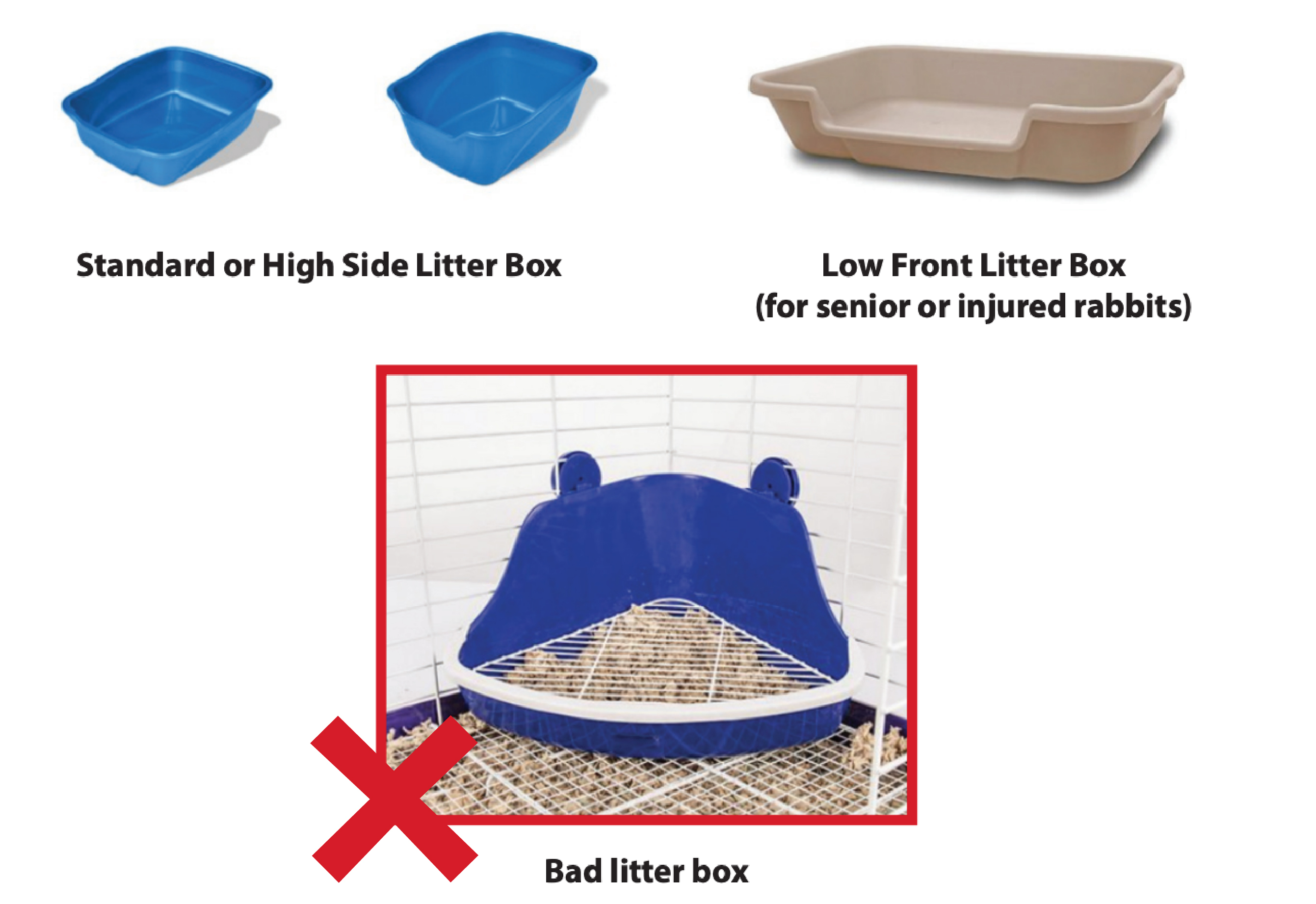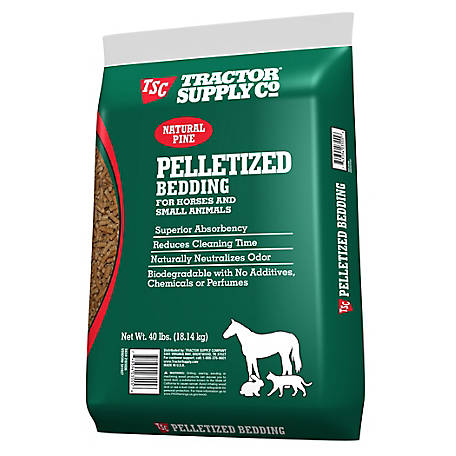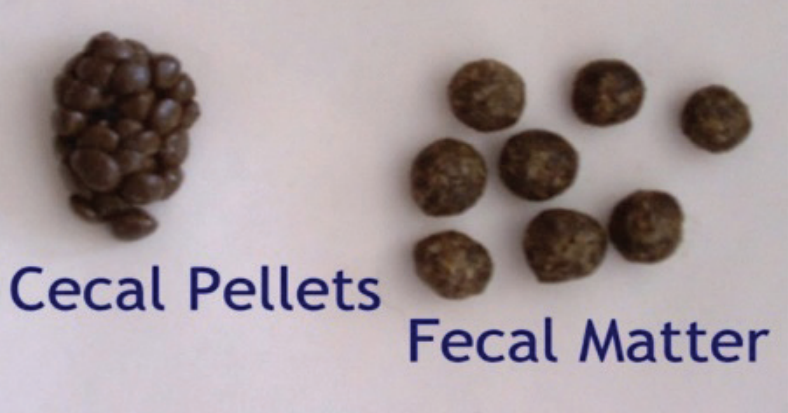Litter Boxes
Rabbits like to spend a lot of time in their litter box, munching on hay and doing their business. Yes, they poop while they eat. There are many types of litter boxes available for purchase and it is important to consider your rabbit's personality and needs before buying one.
Boxes should have NO wire grates—rabbits have very sensitive paws, and this type of flooring can cause sores and infections and require the rabbit to sit in an unnatural position (plastic grates are acceptable).
The box should be large enough for your rabbit to turn around in and lie down if they wish. If the box is too small, they will not use it. They do not have to be pretty; a simple under-bed storage bin can make a great litter box.
ALWAYS put hay in the litter box. You can place it on top of your rabbit's preferred litter (never use cat litter) or place your litter box under or next to your rabbit's hay feeder. This encourages rabbits to use their litterbox.
Two are better than one. If you have a free roam rabbit or notice your rabbit having consistent accidents in the same spots, place a litter box where they are going. Height is important. If the sides are too short, your rabbit might have a few accidents over the edge of the box or might be smart enough to know it can reach the hay from outside of the box. You want to force it into the box to eat the hay. Look for litter boxes with a minimum of 4-inch sides (except in the case of senior rabbits).

Types of Litter
There are several litter options for your rabbit; each has different absorbency, odor, and costs. Use our comparison chart below to help you decide what is right for you and your rabbit. The most common types of bedding include paper, paper pellets, and kilndried pine pellets
Paper bedding expands so you can use less; it is absorbent, helps control odor, and is easy to find at most pet stores, but it is more expensive than other options.
Paper pellets absorb liquid quickly, control odor, are easy to find at most pet stores, and are affordable. CAUTION: Any paper pellet litter that contains baking soda is NOT ACCEPTABLE. Baking soda causes acute respiratory issues in rabbits.
Kiln-dried pine bedding is a preferred litter material. It is highly recommended by rabbit owners, is very inexpensive, absorbs quickly, and controls odor. Pine pellets can be purchased at a feed store or a pet store. CAUTION: Do not purchase wood stove pine pellets that contain any type of accelerant such as those used for fuel. These can be deadly to rabbits.
DO NOT USE clay or clumping cat litter that can be accidentally ingested by rabbits. This can cause digestive issues that may lead to death. Keep your rabbit well away from any cat litter boxes in your home that contain this type of litter. Softwood shavings contain phenols and can cause liver and respiratory damage in rabbits. Scented litter or bedding has chemicals that are not good for a rabbit. These chemicals can cause respiratory issues.

- Pine Pellets (often called horse stall pellets - 40 lb bags very reasonably priced)
- Aspen shavings
- Carefresh (pet stores)
- Feline Pine ORIGINAL (grocery stores)
- Yesterday's Newspaper
SAFE litters for bunny
- Pine and cedar shavings - these products are known to cause respiratory problems.
- Clumping litters are dangerous for bunnies.
- Do not use any cat litter other than regular Feline Pine. Read about the Dangers of pine and cedar shavings.
UNSAFE litters for bunny
Cleaning the Litter Box
No one likes a dirty bathroom. Your rabbit is no different. Keeping the litter box clean is very important to protect your rabbit, as a dirty litter box increases the chance of bacterial infections, respiratory irritations, flies, mites, mold, fungal spores in the litter and bad odors around your bunny. Rabbit urine is filled with calcium and can have a strong-smelling ammonia if the litter box is not being cleaned often enough. Distilled white vinegar is safe for rabbits and a great, inexpensive way to keep the litter box clean.
- Mix one part distilled white vinegar and 3 parts water in a spray bottle.
- Remove the litter and hay from the litter box. Spray the bottom of the box with the vinegar water solution and dry with paper towels or a cloth.
- As needed - example: when you see urine stains or notice lingering odor, pour about 1/2 inch of undiluted distilled white vinegar into the bottom of the litter box covering any stains. Let soak for 10-15 minutes.
- Pour vinegar down the drain and wipe the litter box dry with paper towels or a cloth.
How to clean a litter box short video
Litter Training
- Litter training - House Rabbit Society has great tips on how to Litter Train a Rabbit.
- Litter Training 101 - Printable PDF about Litter Training 101.
The Scoop on Poop
Rabbits poop A LOT! That is one of the first things you will learn as a new rabbit owner. Luckily, healthy rabbit poop consists of dry, scentless, cocoa puff-sized balls that are easy to clean up, especially if your rabbit is litter box trained. Poop can tell you a lot about the health of your rabbit. Illnesses are often detected early by watching for any changes in the size of their poops or pooping habits.
Normal Rabbit Poop Characteristics
Healthy rabbit poop can range from about the size of a green pea to a chickpea. The size of the rabbit does not correlate to the size of the poop. Rabbit poop looks like little round balls. Some distortion may occur when extra fur is ingested and expelled in their poop. The color of normal rabbit poops can range anywhere from a deep brown to a tanner wheat color. Rabbit poop should be dry and hard to the touch, not soft and squishy. Rabbits poop about two hundred to three hundred pellets a day due to their high fiber diet. If your rabbit goes 12 hours without pooping, contact your vet. This can be a sign of early GI stasis symptoms.
Cecotropes
Get ready for a bit of a gross-out moment. Cecotropes, or cecal pellets, are a nutrient-rich dietary expulsion that rabbits produce and consume daily. It is visually different from fecal matter because it resembles a blackberry composed of small soft, shiny balls. You should not usually see these, as your rabbit will typically eat cecotropes as they are expelled. However, a diet too high in carbohydrates, sugar, or protein can upset the balance in the cecum and cause an overproduction of cecotropes. In this case, a rabbit may ignore these extra droppings as they do not require them. If your rabbit's poop changes dramatically in size, shape, color, or texture, please see a vet immediately as there may be a severe medical condition requiring treatment.
